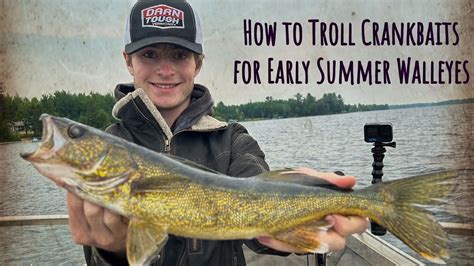How Fast To Troll Crankbaits For Walleye
Ronan Farrow
Apr 04, 2025 · 3 min read

Table of Contents
How Fast to Troll Crankbaits for Walleye: A Guide to Success
Targeting walleye with crankbaits can be incredibly rewarding, but mastering the retrieve speed is crucial for consistent success. Walleye are opportunistic feeders, but their reaction to a crankbait's speed varies depending on several factors. Let's dive into the optimal trolling speeds for maximizing your walleye catch.
Understanding Walleye Behavior and Crankbait Action
Before discussing speed, it's vital to understand how walleye react to different presentations. Walleye are ambush predators, often preferring a slower, more erratic movement that mimics injured baitfish. A crankbait’s action—its wobble, roll, and depth—is heavily influenced by its speed.
The Importance of Crankbait Selection
The type of crankbait you choose drastically impacts the appropriate trolling speed. Different crankbaits are designed for varying depths and actions:
-
Shallow Cranks: These work best at slower speeds, typically between 1.5 and 2.5 mph. At higher speeds, they may run too shallow or skip across the surface.
-
Medium-Diving Cranks: These versatile lures are effective across a broader speed range, generally from 2.0 to 3.5 mph. Experimentation is key to find the sweet spot in your fishing area.
-
Deep-Diving Cranks: These require faster speeds to reach their intended depth, usually between 3.0 and 4.5 mph. However, even with deep divers, you may still need to adjust speed based on water temperature and walleye activity.
Factors Affecting Optimal Trolling Speed
Several environmental factors influence the ideal trolling speed for walleye:
Water Temperature
Colder water temperatures often mean slower walleye metabolism, leading to a preference for slower-moving prey. In cooler waters, slowing your trolling speed to the lower end of the recommended range for your chosen crankbait is often beneficial.
Water Clarity
Clear water allows walleye to see your lure from a distance. Slower retrieves often prove more effective in clear water, allowing the lure to subtly entice a strike. Conversely, in murky water, slightly faster speeds might draw attention from a greater distance.
Walleye Activity Level
Walleye activity varies throughout the day and season. During periods of low activity, a slower, more methodical retrieve is generally best. If walleye are more aggressive, a slightly faster speed may trigger more strikes.
Fine-Tuning Your Retrieve: Techniques for Success
Even within the recommended speed range, subtle adjustments can significantly impact your success. Consider these techniques:
Varying Speed
Don't maintain a constant speed. Incorporating short bursts of faster speed followed by slower periods can create an erratic, more enticing action for walleye.
Using Downriggers or Diverter Weights
Downriggers allow precise depth control, enabling you to target walleye in specific zones. Diverter weights can achieve similar effects while maintaining a more natural presentation.
Observing Your Lines
Pay attention to your lines! Unusual tension, slack, or sudden stops might indicate a bite or a need for speed adjustment.
Conclusion: Experimentation is Key
The ideal trolling speed for walleye with crankbaits is not a fixed number. It's crucial to experiment with speed, crankbait type, and retrieve techniques based on the specific conditions of your fishing location and the walleye's activity. Start with the recommended speed ranges outlined above, and then make gradual adjustments to find what works best for you. Remember, patience and persistence are your allies in the quest to master the art of walleye trolling.
Featured Posts
Also read the following articles
| Article Title | Date |
|---|---|
| How Far Can A Tree Lean Before It Falls | Apr 04, 2025 |
| How Far Is It To Bethlehem Sheet Music | Apr 04, 2025 |
| How Fast Is A Dixie Chopper | Apr 04, 2025 |
| How Far In Advance Should A Guy Ask You Out | Apr 04, 2025 |
| How Good Is A Deers Memory | Apr 04, 2025 |
Latest Posts
Thank you for visiting our website which covers about How Fast To Troll Crankbaits For Walleye . We hope the information provided has been useful to you. Feel free to contact us if you have any questions or need further assistance. See you next time and don't miss to bookmark.
